
In my last post, I argued that terrorists, by their actions, sever any legitimate relationship with a religion and any recognized sovereign, and as such terrorists should be identified as terrorists (e.g., “terrorists have invoked an interpretation of Islam to justify their actions”), even if the terrorists use religion or a disputed regional policy as a justification for their acts. Note that the focus of the proposition is identification of terrorists, and that its purpose was to suggest ways in which a backlash against all Muslims in India could be avoided.
This post generated a significant and spirited reaction. For example, some contended that my argument was typical of the left, of apologists, and of those who fail to understand the demonstrated link between Islam and terrorism. In response, and consistent with the fact that it’s exam time in classrooms and campuses across America, I ask the following:
Who made these statements:
“Ours is a war not against a religion, not against the Muslim faith. But ours is a war against individuals who absolutely hate what America stands for[.]”
“Americans understand we fight not a religion; ours is not a campaign against the Muslim faith. Ours is a campaign against evil.”
“The enemy of America is not our many Muslim friends; it is not our many Arab friends. Our enemy is a radical network of terrorists[.]”
“[T]he war against terrorism is not a war against Muslims, nor is it a war against Arabs. It’s a war against evil people who conduct crimes against innocent people.”
And the kicker:
This enemy tries to hide behind a peaceful faith. But those who celebrate the murder of innocent men, women and children have no religion, have no conscience and have no mercy.
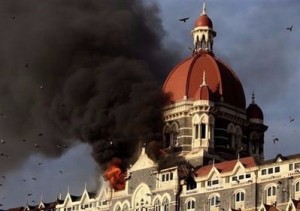 The terrorist attacks in Mumbai — which consisted of blasts in at least seven sites and which apparently targeted Westerners — have, as of this writing, claimed over 110 lives and injured a minimum of 300. Terrorism on this scale has the tendency to engender very common, basic reactions: fear of another attack, concern for those who are at or near the location(s) of the attacks, care for friends or family who may have loved ones affected, disbelief that one set of humans can do this to other humans, and an interest in why the terrorists did what they did. All these elements were present in the wake of 9/11 and the 7/7 bombings, and I believe have been resurrected again with the Mumbai attacks.
The terrorist attacks in Mumbai — which consisted of blasts in at least seven sites and which apparently targeted Westerners — have, as of this writing, claimed over 110 lives and injured a minimum of 300. Terrorism on this scale has the tendency to engender very common, basic reactions: fear of another attack, concern for those who are at or near the location(s) of the attacks, care for friends or family who may have loved ones affected, disbelief that one set of humans can do this to other humans, and an interest in why the terrorists did what they did. All these elements were present in the wake of 9/11 and the 7/7 bombings, and I believe have been resurrected again with the Mumbai attacks.
There is another aspect of a response to mass terrorism that I’d like to discuss in this post: the inclination to unfavorably treat those who share characteristics with or bear resemblance to the terrorists. Following 9/11 and 7/7, Muslims and those perceived to be Muslim were subject to a pervasive and violent backlash. (As we reported earlier this week, Sikhs in America have been profiled in the airport setting.) Accordingly, with news accounts suggesting that the Mumbai terrorists are Muslim, some are worried that Muslims in India may face a wave of public and/or private harassment and discrimination. For example, a colleague who heads a major civil rights organization in America expressed that he was “praying for victims of [the] Mumbai attack[s] and for Muslims in India.”
It should not have to be this way.
A new contest + award is in place for Sikhs. Who will be the Chic Sikh of the Year for 2008?
The sponsor is Sikhchic, the online magazine which promotes Sikhs in the arts (and also invites articles on an array of subjects). The nomination process is completely transparent, which make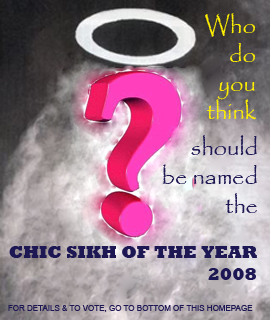 s it interesting. Anyone can nominate by simply entering a nomination and the reasons for it as a comment. It then gets posted, so you can see all of the nominations here. So far, the illustrious nominees include: Prime Minister Manmohan Singh, the Singh Twins, Fauja Singh, Amandeep Singh Madra, and I.J. Singh.
s it interesting. Anyone can nominate by simply entering a nomination and the reasons for it as a comment. It then gets posted, so you can see all of the nominations here. So far, the illustrious nominees include: Prime Minister Manmohan Singh, the Singh Twins, Fauja Singh, Amandeep Singh Madra, and I.J. Singh.
The award doesn’t have to be awarded to a Sikh. It’s unclear how much of a connection a nominee has to have to the Sikh community- whether they have to commit a Sikh-like deed or act to somehow promote/improve the Sikh community. It also doesn’t have to be to a person- it can be to an institution. There are many organizations that have done some really interesting things in the past few years for the Sikh community, and I’m sure we’ll be seeing some of them nominated.
Awards validate ideals- confirm that they mean something. It ‘s unclear so far what ideals this award will recognize since the parameters for nomination have been left purposefully vague. I guess we’ll know more when an awardee is chosen.
In a recent THL discussion on Prop. 8 we have been addressing the use of Sikh principles in taking a position on homosexual marriage.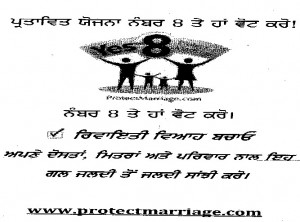 At a recent Nagar Keertan in Yuba City, California there were “Yes on Prop. 8” fliers along with the really interesting T-shirts. Thus, I think religion is an important part of the discussion on Prop. 8 because there is a reason why this state-related material is at religious events. Religion is a moral compass that guides many people’s decisions in all kinds issues. Thus, I don’t condemn those who have used religion as their moral source for voting Yes or No on Prop. 8. However, I do disagree with how Sikh scripture has been misused as “rules” rather than concepts that guide our decisions. I attribute these actions to a general lack of understanding and education around the Guru Granth Sahib Ji in our community. This education is a fundamental issue we as a Quam need to find practical solutions for rather than blame people for not knowing.
At a recent Nagar Keertan in Yuba City, California there were “Yes on Prop. 8” fliers along with the really interesting T-shirts. Thus, I think religion is an important part of the discussion on Prop. 8 because there is a reason why this state-related material is at religious events. Religion is a moral compass that guides many people’s decisions in all kinds issues. Thus, I don’t condemn those who have used religion as their moral source for voting Yes or No on Prop. 8. However, I do disagree with how Sikh scripture has been misused as “rules” rather than concepts that guide our decisions. I attribute these actions to a general lack of understanding and education around the Guru Granth Sahib Ji in our community. This education is a fundamental issue we as a Quam need to find practical solutions for rather than blame people for not knowing.
That said, I believe a fundamental part of Sikhi is love … the morality of love. It’s not the happy happy love or perfect one that excuses all actions, but the one that makes us human enough to see the light of Waheguru in all …. even those we detest. What is this love … I think Khalil Gibran poignantly explains it in his book “The Prophet”:
“For even as love crowns you so shall he crucify you. Even as he is for your growth so is he for your pruning. Even as he ascends to your height and caresses your tenderest branches that quiver in the sun, so shall he descend to your roots and shake them in their clinging to the earth.”
Barack Hussein Obama’s historic victory as the 44th President of the United States Of America is being celebrated not only in America, but across the world.
He said in his victory speech that:
This victory alone is not the change we seek. It is only the chance for us to make that change. And that cannot happen if we go back to the way things were.
It can’t happen without you, without a new spirit of service, a new spirit of sacrifice.
So let us summon a new spirit of patriotism, of responsibility, where each of us resolves to pitch in and work harder and look after not only ourselves but each other.
Thus, I leave you with a BBC news clip on how the World is reacting to Obama’s win. As people celebrate across the world, they also offer what they believe this “chance” for “change” means for American foreign relations!

As we decide on the presidential candidate we will vote for this election year, their values, thought-processes, and interactional styles are as important as their policies. I feel regardless of who wins the election, their policies will ultimately change during their presidency. George Bush Senior said he would provide tax-cuts during his presidency and ultimately raised them. Bush Two wanted smaller government, but added the Office of Homeland Security. Bill Clinton promised health-care reform for insuring more Americans, but when he left office “ … there were at least 3 million more people uninsured in the U.S.”. The only stability these candidates can provide us are their values, thought-processes, and interactional styles because, at both of their ages, habits generally don’t change. These habits rooted in personality and experience, will provide insight into what kinds of policy decisions they are more likely to make when policy changes occur during their presidency for various reasons. Each candidate’s current stance on policies during the campaign season and voting record are crucial for providing insight into their values and thought-processes, but they should not be the sole measures for determining who is the better candidate. For example, how they interact at debates is critical because it reveals temperament and interactional style for engaging in “heated” moments we can expect our leader to encounter domestically and internationally, particularly after the state-of-affairs Bush is leaving us with. These debate moments along with those on the campaign trail also show us how these candidates will work “across the table” with red AND blue politicians to get legislation passed. Ultimately, we know there won’t always be a foreign policy advisor or a “cheerleader” to hold either of these candidates’ hands during these “heated” moments when you just have to act, while ensuring you’re doing the best for the American people and upholding American principles and ethics.
So another way of gaining insight into a person’s values, thought-processes, and personality is how they make and spend their money, particularly campaign money. We have heard of the battle of McCain and Obama robo-calls and Obama campaigning through video games, but what’s the overall picture look like … click here and here to decide for yourself!
Let’s us know what you think!
As Belgian Sikhs celebrated the 300th anniversary of the Sri Guru Granth Sahib Ji, immigration police raided the Vilvoorde gurdwara, arresting 30 [link].
Police swooped on 19 suspected safe-houses in Brussels and surrounding suburbs during dawn raids on Saturday and discovered over 200 immigrants. The gangs ringleaders are said to be among 15 people arrested. Police also found 50 illegal immigrants hiding in a Sikh temple in Vilvoorde, a suburb north of Brussels. [link]
Officials say the raid was to break up an underground ring that was trafficking young, undocumented (Indian) Sikh men through Belgium to the U.K.:
The criminal gang, which charged Asian migrants over £15,000 for their journey from India via Moscow, is thought to have smuggled “thousands” of illegal immigrants in Britain over the last year and a half. [link]
Human trafficking notwithstanding, officials chose to coordinate their sting on the same day hundreds of Sikhs were holding Akhand Path for SGGS Ji’s tercentenary. From the accounts so far, police barged into the gurdwara, boots on, heads uncovered, and went through with their sting operation. By word of mouth, individuals said that even those who showed evidence of documentation were arrested for alleged trafficking.
If individuals in the community were trafficking under the conditions described, their actions are horrific. I am deeply troubled by the police decision to exploit a religious holiday, disrespect the religious observance of a minority, and then proceed to terrorize the congregation by “busting” traffickers and undocumented migrants. It reminds me of the abusive tactics I.C.E. has used in raiding homes and places of worship in Latino communities, preying on both the documented and undocumented. But what does this say for a country’s concepts of sanctuary and protection of minority communities? The gurdwara is always supposed to be a haven, a safe shelter, for anyone, including the indigent or oppressed. If it was used to further ill purposes, I don’t know what to say, but if it was used to protect undocumented migrants who were moving through the country as a matter of conscience, then what does this kind of militaristic and predatory behavior do to the relationship between the state and its people?
So this past Saturday, Tina Fey, did a great job impersonating Sarah Palin’s “performance” at the Vice Presidential Debate on SNL. The body language, voice, and choice of words were right on and HILARIOUS!
Yesterday, Robin Abcarian, of the Los Angeles Times, wrote about the debate of body languages between Obama and McCain during this week’s Presidential Debate.
Abcarian wrote:
Obama sat like a jazz musician on his chair, one heel hooked at an angle, while McCain sat as if he might leap up at any moment, or stood impatiently waiting for his turn to speak.
Glass, a body language expert said that McCain was, “… like the Energizer Bunny [who] had some batteries put in. “We have never seen McCain so warm and fuzzy and likable and dynamic.”
This same expert thought that, “… Obama seemed unnatural at times. “Somebody coached him and did not do him a favor,” she said. “When he talks about an issue he’s passionate about, his gestures are fluid and real, but other times, he took his index finger and clasped it to his thumb, and it’s phony, it’s not real.”
However, at the end of the debate, body language experts declared Obama as the winner because “… a debate is won in the first 15 minutes and lost in the last two … Obama closed on a higher note than McCain.”
For our readers, who watched the Presidential Debate, what body language or mannerisms did you notice that would be great for another Saturday Night spoof?
From the Volokh Conspiracy:
Dear Senator McCain:
Repeatedly calling me and everyone else in the United States “my friends” is extremely annoying. In part, it’s just an irritating phrase. Beyond that, I’m not your friend. I don’t know you, and, from what I know of you, I don’t even really like you. Sorry to focus on such superficialities when the world economy is going to Hell, but you probably lost more votes with your constant repitition of “my friends” than from anything Obama said.
Sincerely,
David B. [link]
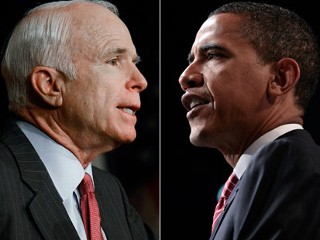 Reema (I’m signing on.)
Reema (I’m signing on.)
Both candidates used the phrase. And of course, because of my bias, it grated on my nerves when McCain used it. It was just amusing when Obama did. Anyone who is about to control my life and the lives of all US residents is not a friend, and they shouldn’t try to be. They just better know what they’re doing because everything (economy, environment- one in 4 mammals is threatened with extinction, social security, Medicare + Medicaid) seems to be falling apart at the same time. Not to be dramatic or anything. The only suggested economic solution from a Sikh point of view I found was vague, overly ambitious, and not really very palatable either.
In an effort to better understand the food habitats of Panjabi immigrants, Canadian researchers conducted a three-year study on the ingredients used in daily Panjabi meals and food choices made by Panjabi families.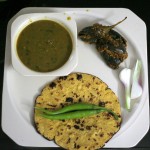
Gwen Chapman, study leader and British Columbia University nutrition professor, stated:
“Since cardiovascular diseases and type II diabetes are more prevalent among Indians and they are linked to food habits, we wanted to understand what ingredients went into daily Punjabi or Indian meals.”
An important part of study was also understanding how cultural affiliations play a role in Panjabi immigrant food choices.
Researchers found that “in Punjabi families in British Columbia … separate meals are often prepared to accommodate elders who need traditional roti, daal and subji, and younger family members who prefer to balance Indian and “Canadian” foods.”
While reading this article I thought about how these food choices actually play out in immigrant Panjabi homes across North America. I remember the rotis without butter for those who have high cholesterol and the weekend meal of burger and fries for us “American” kids. There were also the interesting “masalaa” pastas, lasagnas, and pizzas that had a “Panjabi” twist (i.e. tons of garam-masalaa). I recall uncles’ refusing to eat “kaa-foos” prepared by their wives, aunties making tofu-sabiji, and mothers’ substituting olive oil for vegetable oil when making tarkas. Many of these food choices were an effort to provide more healthy meals as a “preventive” form of action against heart disease and diabetes; while others were made to satisfy taste-buds.
So I was wondering what interesting food choices have you seen Panjabi families make in the Diaspora both to satisfy taste-buds and become more healthy?
Earlier today I stumbled on this article in the Montreal Gazette detailing the suspension, and now calls for a speedy trial, for a Sikh boy accused of assault:
The teenager made his first appearance on the charges in Montreal Youth Court yesterday where he pleaded not guilty to three counts alleging he used a kirpan, a Sikh religious object that resembles a dagger, to threaten his schoolmates.
This case comes on the heels of another landmark Quebec case in which Canada’s Supreme Court unanimously voted to protect the right of Sikh school children to wear the kirpan (with some limitations on its use) in 2006.
But did the boy actually draw, or use, his kirpan during the argument? At first blush, it sounds like this was a schoolyard disagreement, but if the boy drew his kirpan it would be incredibly inappropriate, both under dharmic understandings and under school policy. But on reinspection, it’s unclear if this incident actually ever happened, or if this is a racist reaction against the kirpan. The boy’s lawyer, the same man who argued the Supreme Court case for accommodation of the kirpan, believes the reaction is racist:
Grey accused the Montreal police and the Marguerite Bourgeoys school board of “overreacting.” He also said a large part of Quebec society has never accepted the Supreme Court’s decision.
“I think that what we’re witnessing – it’s my opinion and the court will decide – is a deep bias against the kirpan that has never died in Quebec…”
If his lawyer is correct, then this brings up a larger issue: how do inclusion policies and values translate on the ground if a region or group is hostile to accommodation?
Legal protection of the kirpan is vitally important and relevant and worth protecting, but, if this incident did not take place, how many Sikh children will be pressured, harassed, and suspended from schools for exercising their right to practce their faith? In this case, the school board is not an advocate for the Sikh child (and in the previous kirpan case, when the school drafted an accommodation policy it was invalidated by the school board as well); if that democratic channel fails, then how can we support families in this position?
In the aftermath of the September 11, 2001 terrorist attacks, Muslims and Arabs in America engaged in various efforts to respond to the post-9/11 backlash. 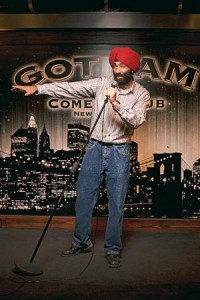 For example, in the halls of Congress they advocated against discriminatory security measures and in the courts of law they pressed allegations of employment discrimination and airport profiling.
For example, in the halls of Congress they advocated against discriminatory security measures and in the courts of law they pressed allegations of employment discrimination and airport profiling.
Muslim- and Arab-Americans also turned to another, perhaps less conventional forum: stand-up comedy clubs. For example, a comedy show, “Allah Made Me Funny,” was “an attempt by a group of American Muslim comics to counter the negative stereotypes and attitudes about Muslims and Arabs by poking fun at themselves, their communities and the prejudices they face.” [Link; see also here, here, and here.]
The latest edition of Newsweek contains an article by one Sikh, Narinder Singh, regarding his attempts to use comedy for the same purpose.
Jagmohan Malhi has become New Zealand’s first officer to wear the custom police turban. Following in the footsteps of the British constabalry (who also have specially tailored turbans), and the MTA, New Zealand 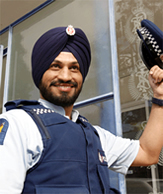 adopted the new attire after Malhi’s campaign to include the turban in the uniform.
adopted the new attire after Malhi’s campaign to include the turban in the uniform.
Interestingly, Malhi discusses the many challenges and accommodations he’s made since coming to the New Zealand, including cutting his kes and dari when he first arrived. I found this move towards practice really interesting; Malhi mentioned that he wanted to make this possible out of respect for his dying father’s wishes.
Is this the “right” rationale for this move? On one hand, I think it’s admirable and important for there to be the option and existence of visible Sikh officers in New Zealand’s police force. On the other hand, how do we make this possible, and how do people come to this place?
In the past, several posts have focused on the work of the Sikh Coalition around community mobilization to fight school bullying and the launch of an educational tool. 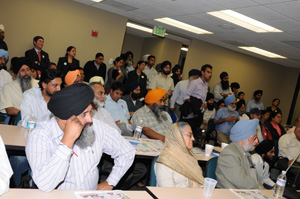 As part of the Sikh Coalition’s on-going work, it has opened a new office in Northern California to provide coast–to-coast civil/human rights advocacy for Sikhs. On September 10th, over 100 attendees, including local community members and politicians, celebrated the Sikh Coalition’s office opening in Fremont, California.
As part of the Sikh Coalition’s on-going work, it has opened a new office in Northern California to provide coast–to-coast civil/human rights advocacy for Sikhs. On September 10th, over 100 attendees, including local community members and politicians, celebrated the Sikh Coalition’s office opening in Fremont, California.
The Coalition’s, Western Regional Director, Neha Singh, said:
“Fremont is nationally the heart of the Sikh community … since we started, we’ve always taken cases from around the country, and a large amount of them were from the Bay Area. We thought it was now time to open an office in an area where a lot of the people requesting our services were.”
On Wednesday, August 27, the Delhi High Court sentenced 4 men (Lal Bahadur, Ram Lal, Virender and Surinder Pal Singh) to life in prison, eighteen years after a trial court acquitted them for lack of evidence. The men were charged with rioting, murder, and conspiracy, related to the deaths of Rajinder and Sardool Singh who were burnt alive on November 1, 1984 and their property looted in Sagarpur. The 4 men were also fined Rs. 21,000 each (about $481.43 per person). The High Court stated:
“it is a case where the members of one community were singled out and were murdered and their properties were burnt and looted. Such lawlessness deserved to be sternly dealt with”. [link]
Interestingly, the court found that conspiring to commit a crime was equal to committing the actual crime (I’m assuming that “members of unlawful assembly…in prosecution of the object…” is conspiracy; it’s unclear from the press release whether this is for conspiracy to riot/murder/combination):
“We may observe here that the liability of the members of unlawful assembly who knew that an offence was likely to be committed in prosecution of the object for which they had assembled is equal to those who commit it,” the Bench observed in a judgement on an appeal filed by the state challenging the trial court’s acquittal order. [link] (emphasis added)
 According to a couple of sources, the state appealed the case after the trial court found there wasn’t enough evidence in 1990. If this is true, and not just bad journalism (fabricated facts inserted into the press release), I wish I could congratulate the prosecutors who pursued and won this case.
According to a couple of sources, the state appealed the case after the trial court found there wasn’t enough evidence in 1990. If this is true, and not just bad journalism (fabricated facts inserted into the press release), I wish I could congratulate the prosecutors who pursued and won this case.
A sessions court had earlier on October 31, 1990, acquitted the accused due to lack of evidence. But the state had challenged the judgment in the Delhi high court stating that it have enough evidence to nail the accused persons. [link]
Langa(w)riters have posted on AIDS/HIV infection amongst Sikh women here and here. We have discussed issues around support groups and causes of infection. One of the number one risk factors for contracting HIV/AIDS for Punjabi Sikh women is marriage. Many women are infected by their husbands who are intravenous drug addicts and/or clients of prostitutes. Not only are these women’s lives reaped with more havoc at no fault of their own, but there is also an insurmountable amount of stigma these women endure.
This past week, a Sikh woman, Kiranjit Kaur, stood up with tremendous strength and bravery to help combat this stigma. She become the poster-woman for people living with HIV/AIDS in Malaysia. At the age of 35, Kaur has decided to put her face to this disease because “I am here to help the ‘positive’ community and empower them and tell them they are not alone.”
Kiranjit Kaur contracted HIV in 1996 through her husband who was a former drug addict and has since passed away.
After contracting the disease she began working full-time with the Asian Pacific Council on AIDS Services as an advocate for other HIV/AIDS patients.
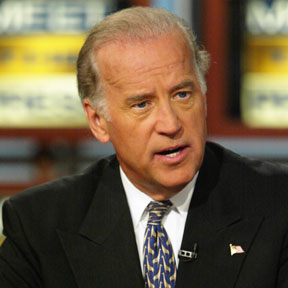 Once again, Indian-Americans have been unwillingly thrust into the heart of a contentious American political battle. For those of you who don’t remember, in 2006, incumbent Senator George Allen singled out and subsequently called an Indian-American, S.R. Sidarth, “macaca” while on the campaign trail. See video here. As The Washington Post’s national political reporter noted, Allen’s use of that slur was a “turning point” in his failed reelection bid, and became “an everlasting part of the political landscape.”
Once again, Indian-Americans have been unwillingly thrust into the heart of a contentious American political battle. For those of you who don’t remember, in 2006, incumbent Senator George Allen singled out and subsequently called an Indian-American, S.R. Sidarth, “macaca” while on the campaign trail. See video here. As The Washington Post’s national political reporter noted, Allen’s use of that slur was a “turning point” in his failed reelection bid, and became “an everlasting part of the political landscape.”
Just a few days ago, presumptive Democratic nominee Barack Obama selected fellow Senator Joe Biden to serve as his running mate. In 2006, Senator Biden said, “In Delaware, the largest growth of population is Indian-Americans, moving from India. You cannot go to a 7-Eleven or a Dunkin’ Donuts unless you have a slight Indian accent.” See video here.
Senator Obama’s decision has generated renewed interest in the 7-Eleven gaffe. See, e.g., here and here. The question is, should we care? In this post, I argue “yes.”
From 7-Elevens to liquor and 99 cents stores, many Panjabi Sikh immigrants build a life for themselves as store workers. Working at these locations gives them a start in America, while engaging with its harsh realities. Regardless of educational background or the pind/shari divide, Panjabi Sikh immigrants work long hours into the night seven days of week trying to build a stable economic future for them and their families. On August 04, 2008, Inderjit Singh Jassal at the age of 62, was one of these Panjabi Sikh immigrants, who was murdered at a 7-11 store during his usual 13-hour shift in Phoenix, Arizona. Jassal had moved to the US nearly 20 years ago, while his wife and two adult children remained in India.
SALDEF reports that:
Mr. Jassal was working at a 7-11 store in West Phoenix when a black male, later identified as 27 year-old Jermaine Canada, walked in with his two children, aged 2 and 6. According to the surveillance video, the two individuals had a short conversation, at the end of which Mr. Canada pulled a concealed firearm from his shirt and fatally shot Mr. Jassal.
The most ironic aspect of this case is that no motive as been found. According to surveillance video there was no angry exchange between Jassal and Canada and nothing was stolen by the murderer.
SALDEF believes that this killing was nothing other than “… a heinous crime motivated by hate”.
According to one of Canada’s relatives, he had a history of drug abuse and mental illness. At the time of the killing, he was under supervised release following 2 years in prison for violating his probation, for a prior dug conviction, with a weapons charge.
Currently, Tajinder Singh Jassal, a nephew of Inderjit Singh Jassal and co-worker, is working to get immigration visas for Inderjit’s wife and children. He is considering sending an appeal letter to Arizona Senator John McCain’s Office for assistance with the visas because “The family is suffering right now. They want to see their father’s face.”
Over a year ago, Ajmer Singh Hothi was found shot dead inside a semi-truck that he had just bought and was still making payments on. Only a day before, he had changed his phone number and gotten a restraining order against his ex-girlfriend and her father. [link]
 More information surrounding the case has recently became available since 553 pages of court records from a grand jury hearing have become public.
More information surrounding the case has recently became available since 553 pages of court records from a grand jury hearing have become public.
A prosecutor accuses Gurparkash Khalsa of being driven by humiliation over his daughter’s soiled reputation to the point of ambushing Hothi in a big rig parked east of Stockton. The 56-year-old now sits in a jail cell charged with capital murder… Details of the case recently became public when San Joaquin County Superior Court Judge Charlotte Orcutt unsealed the 553-page transcripts of a four-day grand jury hearing that ended with Khalsa’s April 25 indictment. He was arrested hours later. [link]
The events that led to Ajmer’s death began with a relationship between Hothi and Khalsa’s daughter.
It began in November 2004, when a secret romance sparked between Hothi and Khalsa’s daughter, Kiranjot Pannu, then age 17. The lovers kept it quiet because Hothi was a lowly trucker, while her father owned Pacific Coast Intermodal in French Camp. Hothi’s father, also a trucker, once worked for Khalsa and feared him, according to Hothi’s sister, Kiranjit Hothi, who testified before the grand jury. [link]
Khalsa forbade the romance and Hothi’s parents sent Ajmer to India for an arranged marriage. But then Khalsa heard rumors that Hothi had gotten his daughter pregnant, and that she’d had an abortion. The angry father then demanded that Hothi marry his daughter. He followed Ajmer to India and tried to have him divorced. It seems that he was unsuccessful, and word of his attempt traveled back to Stockton where Khalsa felt humiliated in the eyes of the community. [link]
I remember going to Nagar Kirtans and being awed by those doing Gatka (i.e. Sikh martial arts)! Their “performances” were eye-catching with action, discipline, determination, and spirituality. Watching Gatka helped me connect with Sikh history at a time when there were little resources around me to learn about Sikhi. This martial art gave me some insight into the concept of a “saint-solider” – one who exemplifies Miri/Piri (spiritual/temporal power). I got to see how a saint-solider physically fought to defend Sikhi.
Lately, I have heard people ask, “Is Gatka a “performance” or a “martial art”? I think the “performance” part of the question comes from those who think Gatka is being done more to please crowds than spiritually connect with Sikhi. Also, some think Gatka techniques are being compromised in order for it to be more “safe” for crowd performances? I personally think, Gatka is both a performance and a marital art, but that does not mean spirituality or technique has to be compromised. What do others think?
A recent BBC show on Gatka addressed how it is becoming a way for Diasporic youth to connect to their Sikh heritage, while focusing on physical fitness. It also touches on non-Sikhs participating in Gatka. Let us know what you think!
p.s. I have always found it empowering to see Sikh girls participating in Gatka, even though I rarely see women on Gurdwara management committees!

